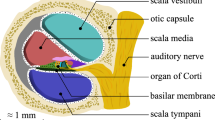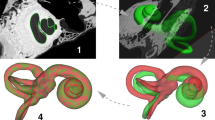Abstract
Cochlear implantation consists in electrically stimulating the auditory nerve by inserting an electrode array inside the cochlea, a bony structure of the inner ear. In the absence of any visual feedback, the insertion results in many cases of damages of the internal structures. This paper presents a feasibility study on intraoperative imaging and identification of cochlear structures with high-frequency ultrasound (HFUS). 6 ex-vivo guinea pig cochleae were subjected to both US and microcomputed tomography (µCT) we respectively referred as intraoperative and preoperative modalities. For each sample, registration based on simulating US from the scanner was performed to allow a precise matching between the visible structures. According to two otologists, the procedure led to a target registration error of 0.32 mm ± 0.05. Thanks to referring to a better preoperative anatomical representation, we were able to intraoperatively identify the modiolus, both scalae vestibuli and tympani and deduce the location of the basilar membrane, all of which is of great interest for cochlear implantation. Our main objective is to extend this procedure to the human case and thus provide a new tool for inner ear surgery.






Similar content being viewed by others
References
Bezanson, A., R. Adamson, and J. A. Brown. Fabrication and performance of a miniaturized 64-element high-frequency endoscopic phased array. IEEE Trans. Ultrason. Ferroelectr. Freq. Control 61:33–43, 2014.
Braun, K., F. Böhnke, and T. Stark. Three-dimensional representation of the human cochlea using micro-computed tomography data: presenting an anatomical model for further numerical calculations. Acta Otolaryngol. 132:603–613, 2012.
Brendel, B., S. W. A. Rick, M. Stockheim, and H. Ermert. Registration of 3D CT and ultrasound datasets of the spine using bone structures. Comput. Aided Surg. 7:146–155, 2002.
Brounstein, A., I. Hacihaliloglu, P. Guy, A. Hodgson, and R. Abugharbieh. Towards real-time 3D US to CT bone image registration using phase and curvature feature based GMM matching. Med. Image Comput. Comput. Assist. Interv. 6891:235–242, 2011.
Brown, J. A., Z. Torbatian, R. B. Adamson, R. Van Wijhe, R. J. Pennings, G. R. Lockwood, and M. L. Bance. High-frequency ex vivo ultrasound imaging of the auditory system. Ultrasound Med. Biol. 35:1899–1907, 2009.
Buytaert, J., S. Johnson, M. Dierick, W. Salih, and P. Santi. MicroCT versus sTSLIM 3D imaging of the mouse cochlea. J. Histochem. Cytochem. 61:382–395, 2013.
De Seta, D. Quality of insertion in cochlear implants: a clinical and temporal bone study, Université Pierre et Marie Curie - Paris VI; Università degli studi La Sapienza (Rome), 2016. English.
Fuerst, B., W. Wein, M. Müller, and N. Navab. Automatic ultrasound–MRI registration for neurosurgery using the 2D and 3D LC2 Metric. Med. Image Anal. 18:1312–1319, 2014.
Goksu, N., N. Karademir, R. Haziroglu, I. Bayramoglu, Y. Kemaloglu, and N. Akyeldiz. Anatomy of the guinea pig temporal bone. Ann. Otol. Rhinol. Laryngol. 101:699–704, 1992.
Hacihaliloglu, I., D. R. Wilson, M. Gilbart, M. A. Hunt, and P. Abolmaesumi. Non-iterative partial view 3D ultrasound to CT registration in ultrasound-guided computer-assisted orthopedic surgery. Int. J. Comput. Assist. Radiol. Surg. 8:157–168, 2013.
Kakigi, A., A. Kakigi, Y. Takubo, N. Egami, A. Kashio, M. Ushio, T. Sakamoto, S. Yamashita, and T. Yamasoba. Evaluation of the internal structure of normal and pathological guinea pig cochleae using optical coherence tomography. Audiol. Neurotol. 18:335–343, 2013.
Landry, T., G. Earle, J. Brown, and M. Bance. Real-time intracochlear imaging of automated cochlear implant insertions in whole decalcified cadaver cochleas using ultrasound. Cochlear Implants Int. 19:255–267, 2018.
Liu, W., F. Atturo, R. Aldaya, P. Santi, S. Cureoglu, S. Obwegeser, R. Glueckert, K. Pfaller, A. Schrott-Fischer, and H. Rask-Andersen. Macromolecular organization and fine structure of the human basilar membrane—relevance for cochlear implantation. Cell Tissue Res. 360:245–262, 2015.
Markelj, P., D. Tomaževič, B. Likar, and F. Pernuš. A review of 3D/2D registration methods for image-guided interventions. Med. Image Anal. 16:642–661, 2012.
Miracle, A. C., and S. K. Mukherji. Conebeam CT of the head and neck, part 2: clinical applications. Am. J. Neuroradiol. 30:1285–1292, 2009.
Moghari, M. H., and P. Abolmaesumi. Point-based rigid-body registration using an unscented Kalman filter. IEEE Trans. Med. Imaging 26:1708–1728, 2007.
Nguyen, Y., G. Kazmitcheff, D. De Seta, M. Miroir, E. Ferrary, and O. Sterkers. Definition of metrics to evaluate cochlear array insertion forces performed with forceps, insertion tool, or motorized tool in temporal bone specimens. Biomed. Res. Int. 2014:532570, 2014.
Pandey, P., P. Guy, A. J. Hodgson, and R. Abugharbieh. Fast and automatic bone segmentation and registration of 3D ultrasound to CT for the full pelvic anatomy: a comparative study. Int. J. Comput. Assist. Radiol. Surg. 13:1515–1524, 2018.
Paun, P. D., W. Hans, E. Lankenau, T. Just, D. Behrend, and G. Hüttmann. Optical coherence tomography as an orientation guide in cochlear implant surgery. Acta Otolaryngol. 127:907–913, 2007.
Powell, M. J. D. The BOBYQA Algorithm for Bound Constrained Optimization Without Derivatives. Report DAMTP. Cambridge: University of Cambridge, 2009.
Rasoulian, A., P. Mousavi, M. H. Moghari, P. Foroughi, and P. Abolmaesumi. Group-wise feature-based registration of CT and ultrasound images of spine. Proc. SPIE Int. Soc. Opt. Eng. 7625:76250, 2010.
Shin, K.-J., J.-Y. Lee, J.-N. Kim, J.-Y. Yoo, C. Shin, W.-C. Song, and K.-S. Koh. Quantitative analysis of the cochlea using three-dimensional reconstruction based on microcomputed tomographic images. Anat. Rec. 296:1083–1088, 2013.
Snels, C., J. Inthout, E. Mylanus, W. Huinck, and I. Dhooge. Hearing preservation in cochlear implant surgery: a meta-analysis. Otol Neurotol. 40:145–153, 2019.
Torbatian, Z., R. Adamson, R. van Wijhe, R. Pennings, M. Bance, and J. Brown. Imaging the auditory system: a new application of high-frequency ultrasound. In: IEEE International Ultrasonics Symposium, pp. 236–239, 2009.
Wein, W., S. Brunke, A. Khamene, M. R. Callstrom, and N. Navab. Automatic CT-ultrasound registration for diagnostic imaging and image-guided intervention. Med. Image Anal. 12:577–585, 2008.
Wein, W., A. Karamalis, A. Baumgartner, and N. Navab. Automatic bone detection and soft tissue aware ultrasound–CT registration for computer-aided orthopedic surgery. Int. J. Comput. Assist. Radiol. Surg. 10:971–979, 2015.
Winter, S., B. Brendel, I. Pechlivanis, K. Schmieder, and C. Igel. Registration of CT and intraoperative 3-D ultrasound images of the spine using evolutionary and gradient-based methods. IEEE Trans. Evol. Comput. 12:284–296, 2008.
Yan, C. X. B., B. Goulet, J. Pelletier, S. J.-S. Chen, D. Tampieri, and D. L. Collins. Towards accurate, robust and practical ultrasound-CT registration of vertebrae for image-guided spine surgery. Int. J. Comput. Assist. Radiol. Surg. 6:523–537, 2011.
Zitová, B., and J. Flusser. Image registration methods: a survey. Image Vision Comput. 21:977–1000, 2003.
Acknowledgments
This work was supported by the French “Fondation pour l’Audition” and by the French National Agency for Research (Agence Nationale pour la Recherche, ANR) within the Investissements d’Avenir Program (Labex CAMI, ANR-11-LABX0004, the Equipex ROBOTEX, ANR-10-EQPX-44-01). We thank Dr Renaud Lebrun (Montpellier Rio Imaging platform and LabEx CeMEB - Institut des Sciences de l’Evolution - Université de Montpellier - CNRS UMR 5554- Campus Triolet Place Eugène Bataillon 34095 Montpellier Cedex 5) for his contribution in the µCT acquisitions and Dr Pierre Sicard (IPAM platform - CHU Arnaud De Villeneuve - UMR INSERM 1046 - CNRS 9214 - 371 Avenue du Doyen Gaston Giraud 34295 Montpellier Cedex) for his contribution in the HFUS acquisitions.
Conflict of interest
The authors declare that they have no conflict of interest.
Author information
Authors and Affiliations
Corresponding author
Additional information
Associate Editor Ka-Wai Kwok oversaw the review of this article.
Publisher's Note
Springer Nature remains neutral with regard to jurisdictional claims in published maps and institutional affiliations.
Rights and permissions
About this article
Cite this article
Lavenir, L., Zemiti, N., Akkari, M. et al. HFUS Imaging of the Cochlea: A Feasibility Study for Anatomical Identification by Registration with MicroCT. Ann Biomed Eng 49, 1308–1317 (2021). https://doi.org/10.1007/s10439-020-02671-1
Received:
Accepted:
Published:
Issue Date:
DOI: https://doi.org/10.1007/s10439-020-02671-1




